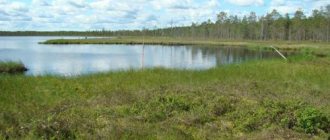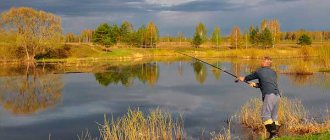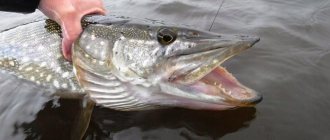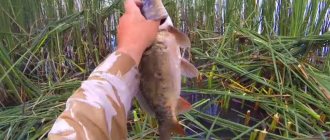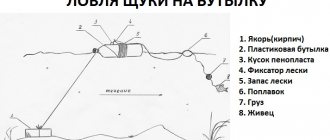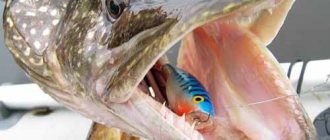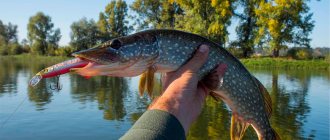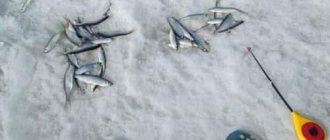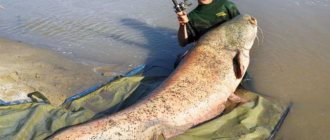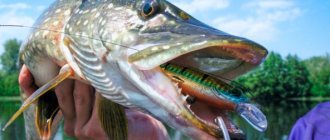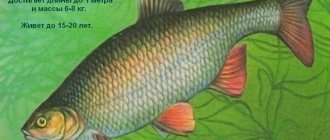Spring is a wonderful time of the year. Everything is blooming, awakening from winter sleep. Including fish. She begins to take an active interest in bait, so the fishing season in the spring is in full swing.
Today we will talk about catching pike with a spinning rod. The hunting season for this aquatic predator can be opened as soon as the ice has cleared from the river. However, you need to approach the process wisely, carefully preparing your gear and bait and finding out when and where the pike bites best. We will understand all these subtleties.
When does pike start biting on a spinning rod in the spring?
With the arrival of spring, the pike begins to eat. She strives to replenish energy reserves lost during the cold season.
The fish's pre-spawning feeding stage begins when the reservoirs are still covered in ice crust in many places. It lasts until spawning, which the fish begins not immediately after the ice melts, but after a short period of time. Therefore, as soon as the water warms up to 7-10 degrees above zero, you can start fishing - you will be satisfied and surprised by the result. At this time, going fishing is especially pleasant, since annoying mosquitoes and flies are still absent, which makes the process extremely comfortable.
During spawning, you can forget about biting and catch. Then the fish is still “sick” after it, regains strength and is not attracted to the bait. This lasts seven to ten days. But when the fish “gets sick”, it begins the second stage of the spring zhora. It is at this time that fishermen can get the fattest pike catch.
If we talk about the time of day, then in the spring you can catch pike with a spinning rod throughout the daylight hours, from morning to evening. In the first half of the day the chances of a good catch are slightly higher.
Catching pike at dusk in the spring is a futile task (unlike in the summer). In March and April there is nothing to do on the water after 8 pm, as well as very early in the morning. It is recommended to go out on the water at 9-10 am. However, there are exceptions to every rule; this is not mathematics with axioms!
The closer we get to summer, the more pronounced the division between morning and evening bites becomes. With the onset of the hottest time of the year, fishermen have to arrive at reservoirs earlier and earlier.
About
When can you start fishing?
The timing of the start of the spring pike bite depends on weather conditions and the type of reservoir where fishing is supposed to be done. If warm, sunny weather sets in in the spring and the water warms up quickly, then the first activity of the predator begins 5–7 days after the end of spawning. In the middle zone, this period occurs at the beginning of May. In the southern regions, the bite begins 2–3 weeks earlier. In northern reservoirs, post-spawning zhor is observed at the end of May - the first half of June. In the case of a cold spring with frequent rains, pike after spawning begin to bite 7–10 days later.
In shallow ponds and lakes, where the water warms up quite quickly, the pike bite begins a little earlier than in high-water rivers. It is better to start catching pike with a spinning rod on the river in the second half of May, when the river water warms up a little and clears after the spring flood. Later, the “toothy” fish begin to be caught in deep sandy quarries with cold water.
Spring pike fishing with spinning rod. Peculiarities
When catching predators in the spring, you need to take into account certain points, which cannot be said about summer or autumn fishing.
- It is best to fish in shallow water - the fish prefers to live in places with standing water, where the depth does not exceed 1.5 meters.
- It is recommended to use small-sized baits whose retrieve speed is low. The predator at this time is still weak after spawning and will not go after large prey, which, in addition, also moves quickly.
- In some regions there is a spawning ban on catching pike in the spring.
Fishing for pike in early spring with a spinning rod
As mentioned above, in early spring in some regions it is prohibited to catch pike by any means (including spinning). In addition, if the harsh winter is behind us, there is still ice in many bodies of water. So you should postpone your fishing trip.
If there is no spawning ban, and all the ice has disappeared, then it is better to hunt pike in small rivers and creeks, as well as at the mouths of streams that flow into lakes.
In March, there is very changeable air pressure and temperature, so it is unknown when a great bite will overtake you - in sunny or cloudy weather. The best time to fish this month is morning and evening.
During the pre-spawning period, pike attacks any bait, even the most primitive ones. Therefore, spinners have a chance of a good catch.
Pike on a spinning rod in April
In April, pike usually bite poorly and are caught using spinning rods. The fish is either in the process of spawning, or has just finished it, and therefore is “sick.” In addition, April is characterized by floods, when pike stand in the coastal zone, among the reeds.
If during this period the predator goes out hunting, it is only in shallow water, where it can profit from small fish. There is no point in looking for it at depth at this time.
Another disadvantage of catching a predator using a spinning rod in April is that the fish begins to sort through the bait. She will no longer throw herself at anything. Simply put, April is considered far from the best month for catching pike with a spinning rod - you will only waste your time and effort.
About
Fishing in May
In late spring, the water finally subsides, clears and begins to warm up. Flooded bays with grass become overgrown, become too shallow, and local pike move a little deeper from them. Passing pike gradually roll down, and in reservoirs and large rivers return to their summer habitats. And now the toothy one can be found wherever there are convenient ambush sites and forage fish. These include both overgrown quiet shallow waters and medium depths with snags, irregularities, as well as channel edges.
- The pike bite in the spring on a spinning rod gradually levels out by summer - it takes better in the morning and evening, or on quiet cloudy days. At the same time, in cold water, on the contrary, it takes better when it is warm, closer to lunch.
- In spring, fishing features completely depend on the characteristics of the reservoir and the weather. Muddy water – use acidic colors with rattles. Passive bite in clear water - natural colors, sluggish wiring. We experiment with any bait we fish with.
- It doesn’t take it in the grass - we try it at a depth nearby, or in autumn places - deep slopes from reeds into a hole. We use a spinning rod to check any pike spots - rubble of fallen trees, reeds, windows, corners in the wall of thickets, deposits of floating debris in dead ends or at turns, even areas at changing depths or with germinating algae.
- On large bodies of water there are large tables with a dump into a hole, especially if there is a lot of small fish on them. We check artificial shelters - piles, pillars, elements of hydraulic structures.
Article about pike fishing in May
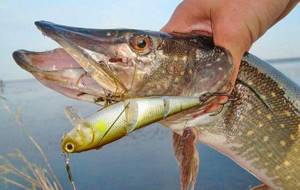
Catching pike in the spring with a spinning rod from the shore
This is the most affordable and easiest option for a fisherman in the spring. You don't need any additional equipment like a boat for this. However, fishing from the shore has its own characteristics:
It is necessary to pay special attention to places where in the spring pike can be most effectively caught using a spinning rod. These are shallow waters well warmed by the sun, areas with aquatic vegetation and flooded bushes.
Spring fishing from the shore involves the use of rods with small weight (up to 20 grams) and a length of no more than 2.7 meters.
Pike fishing from the shore should be done as actively as possible - locations need to be changed extremely quickly. If after 10-15 casts there is no result, move to a new point.
Tactics and fishing techniques
To successfully catch pike in the spring using a spinning rod, an angler will need to follow certain fishing tactics and be able to correctly present the chosen bait.
From the shore
Since pike feeds in the coastal zone in spring, it can be quite successfully caught from the shore. For shore fishing, the fisherman will need a wading suit or waders, which will allow him to get closer to the predator’s camp.
When fishing from the shore, casts are made at approximately 25–45 degrees to the shoreline. If fishing takes place in a shallow bay, then the bait can be thrown at different angles. When fishing, do not rush to cast the bait. It is better to wait for the “toothy one” to come out and precisely throw the bait into the predator’s hunting area. If after several casts to a promising place there is no bite, you should change the fishing area.
Important! When fishing in shallow water, it is important to remember to remain quiet when moving along the shore of the reservoir.
From the boat
Having a boat opens up more opportunities for the angler to find pike. Fishing will be more effective if the angler places the boat 15–30 m from the shore and casts to the very edge of the water.
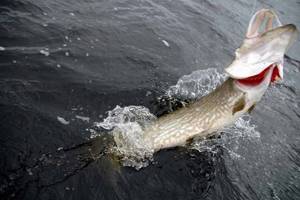
The spring predator desperately resists when fished and gives the fisherman a lot of emotions.
In the spring, pike often stand with their nose to the shore, waiting for frogs jumping into the water, so this tactic often brings good results. In any case, when fishing from a boat, casting should always be done from a deeper place to a shallower one.
Twitching
Since the predator behaves very actively in the spring, when inserting a wobbler, you can use “aggressive” twitching, consisting of several jerks about 20 cm long and a short pause. If for some reason the pike is capricious, the number of jerks can be reduced to one, and the pause time increased to 3-4 seconds, allowing the wobbler to float to the surface.
Jig
When fishing for pike in the spring with a jig, classic wiring works better, in which fast reeling and free fall of the bait alternate. In this case, the bait should be placed not at the bottom, but in the middle layer of water. In some cases, the bait can be given additional animation by slightly twitching the tip of the rod.
Flashing
Oscillating and rotating spoons can be driven either evenly or with short pauses. Retrieving with pauses is necessary if the angler notices that a predator is accompanying the bait, but refuses to attack it. A short stop of the spoon and its slow descent to the bottom often provokes the pike to bite.
If an angler knows when a pike starts to bite in the spring, as well as in what places and what kind of bait it can be caught, then catching a predator will always bring the desired result.
Pike on a jig in spring
Fishing for pike with a jig is especially effective in early spring, as soon as the ice has cleared from the reservoirs. At that time, a large number of predators are still at depth.
It is precisely jig fishing that will become the best assistant when hunting for deep-sea pike. Select small twisters and vibrotails; ideally, their dimensions should be from 5 to 8 cm. The weight of the jig head depends on how rough the current is in the river. Often a device weighing 10 - 15 g is suitable.
Weather for promising fishing
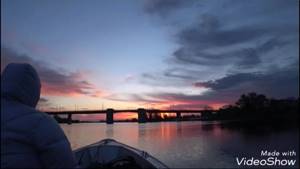
Spring fishing is highly dependent on changeable, capricious weather. At the turn of the year, conditions can change several times a day. Pike, like most fish, is a weather-dependent creature and knowledge of the nuances of behavior depending on weather conditions will help you avoid empty fishing trips.
Atmospheric pressure and air temperature
The most important fishing parameter. Pike loves constant atmospheric pressure. It can be high or low, but constant. During periods of increase or decrease, the fish do not bite.
With sudden changes in air temperature, regardless of other indicators, the pike bite completely disappears.
Lunar cycles
During full moon periods the fish are more lethargic. When the moon wanes, the activity of the fish gradually increases and reaches its peak at the new moon, then gradually declines.
Illumination
During periods of gluttony, this factor is not of great importance. In other periods, cloudy weather or partly cloudy weather ensures active biting all day long.
In early spring, pike become more active on sunny days because the water warms up more intensely. At other times, pike does not like bright light, as well as darkness. The best times are morning and evening hours.
Precipitation and wind
Light and medium lingering rain is the most pike weather. The wind of the southern and southwestern direction, such a force that it raises large ripples on the reservoir, but does not turn into a wave, must also have constant characteristics. When the direction changes and the wind increases, the pike stops biting.
The best lures for pike in spring
Fishermen know pike as a greedy fish that does not particularly care about its safety and is caught by a large number of baits (especially in the spring, before spawning). Sometimes she is ready to grab an almost empty hook.
What to fish with
However, it is better to use high-quality bait when hunting for pike. Among those that bring results to fishermen from year to year, it is worth noting:
- Oscillating spinner. One of the most favorite types of bait among experienced fishermen. A spoon can attract pike with just one leisurely movement that fascinates the fish. It is best to cast the bait a few meters from the probable location of the predator.
- Fishing with live bait. For such bait, it is best to choose medium-sized fish such as small perch or roach. The freshness of the bait is important; it is best if it is still quite active. In this case, you have a better chance of attracting the pike's attention.
- Wobblers. An excellent type of bait. It is popularly called the “pike killer,” which already says a lot. Among them there are both surface models and deep-sea ones.
- Jig baits. Twisters and vibrotails come in a variety of shapes and sizes, but in the spring it is best to use silicone baits at least 5-7 cm in size.
- Poppers. It is best to catch pike with this bait in May, when there is already the first vegetation on the surface of the water.
About
Where to look for a predator
On lakes and reservoirs, pike should be looked for in the coastal zone in spring. At this time, burl fish, which are the main prey of pike, spawn near the coastal grass. The predator goes to a depth of 30–50 cm to feed on spawning roach and rudd.
Attention! On rainy days, when the spawning of carp fish temporarily stops, the predator can retreat to a depth of up to 2.5 m.
On the river, pike can be caught well in shallow bays, the depth of which does not exceed one and a half meters. In spring, a large number of pike can be found in water meadows. The predator enters the meadows during spring floods to spawn eggs. After the level of flood waters decreases, the fish remain isolated from the main body of water and, when there is a shortage of food, greedily rushes to any bait. In floodplain lakes you can also count on a good “toothy” bite.
Tackle and equipment
General characteristics of gear
When choosing a form, proceed from the characteristics of the reservoir and bait. If it is necessary to cast long distances from the shore, the length of the spinning rod will be from 2.2 m to 3.2 meters or more (depending on the casting conditions and the size of the reservoir), for a boat - from 1.4 to 2.7 meters (depending on the size of the reservoir and boats).
Pike is an actively resisting fish. The spinning rod must “work out” all its jerks.
The rods are equipped with:
An inertia-free reel with a sensitive clutch, made of high-quality materials and mechanisms. The speed of cord selection is important - at least three bearings, preferably seven.
A multiplier reel, which is more convenient when fishing for pike, because It has a controlled release of the cord when overloads occur and high traction force parameters.
The use of a strong braided cord, rather than fishing line, is completely justified here. Dark green or gray cords are preferable.
A metal leash-string with a length of 15 centimeters or more must be attached to the end of the cord; the equipment with bait is already attached to it. Fluorocarbon leashes are used according to the fisherman’s preference - there have been cases when a kilogram pike bit through it.
Particular characteristics of gear
The thickness of the line, the size of the spool, the action and test of the rod will depend on the weight of the planned catch.
Cord thickness.
We choose based on the weight of the fish according to the marking of the permissible breaking load.
Reel Spool Capacity:
- For ultralight - spool 1500-2500.
- For the middle class – 3000-3500.
- For “heavy artillery” – 4000-6000.
Selecting a test form
Will be directly related to the thickness of the cord used and the weight of the prey:
- For grass pike (weak currents or standing water), ultralight and light weights up to 10 grams are used.
- On the flow of large rivers - from 10 to 40 grams,
- For heavy prey – up to 40-60 grams.
- For especially large specimens – over 60 grams.
For heavy weights, a slow, parabolic rod action is recommended, regardless of the equipment and bait.
The blank structure will be selected according to the preference in using the bait:
- For jig equipment, we take all fast formations (preference is given to medium-fast).
- For “oscillators” – medium and medium-slow tuning.
- For all other lures - slow action.
☸ A few words about the gear
A spinning rod for catching spring pike must perform three tasks at once: cast the bait far and accurately, allow it to be given the desired animation, and withstand the jerks of aggressive prey. Experienced fishermen advise assembling a kit consisting of:
- a high-quality medium-fast action rod with a length of up to 2.4 meters and a test range of 5-25 g;
- reels with a convenient front drag, high gear ratio and spool capacity of 2000;
- braided fishing line, the diameter of which is selected taking into account what species are found in the reservoir (for example, for a grass weighing no more than 1 kg, 0.12 mm braid is suitable);
- a leash made of metal or fluorocarbon (the first is more reliable, the second is less alarming to the fish);
- bait selected in accordance with the preferences of the predator living in a particular body of water.
It must be said that fishing for pike in early spring with a spinning rod has some peculiarities. After winter it is sluggish and weak, and does not offer such serious resistance as in summer. It happens that she comes straight out of the water, as if dead. Therefore, there is no point in using a rough, heavy spinning rod; you can completely get by with a more delicate tool.

